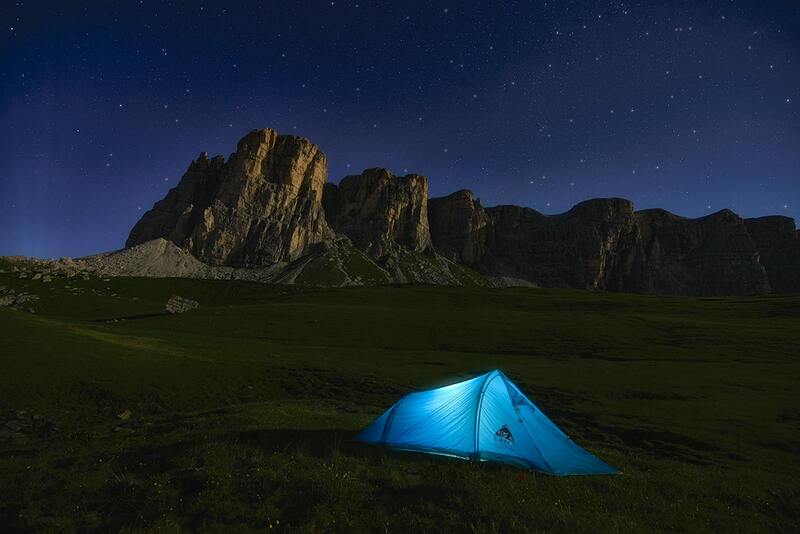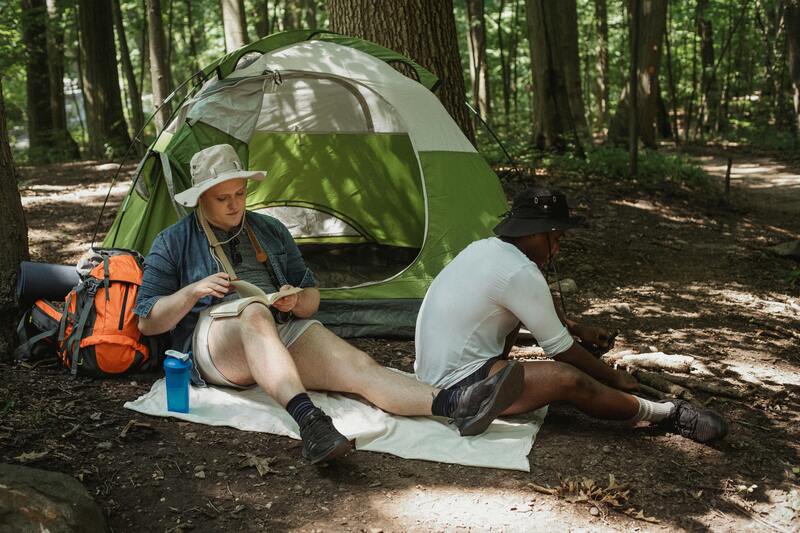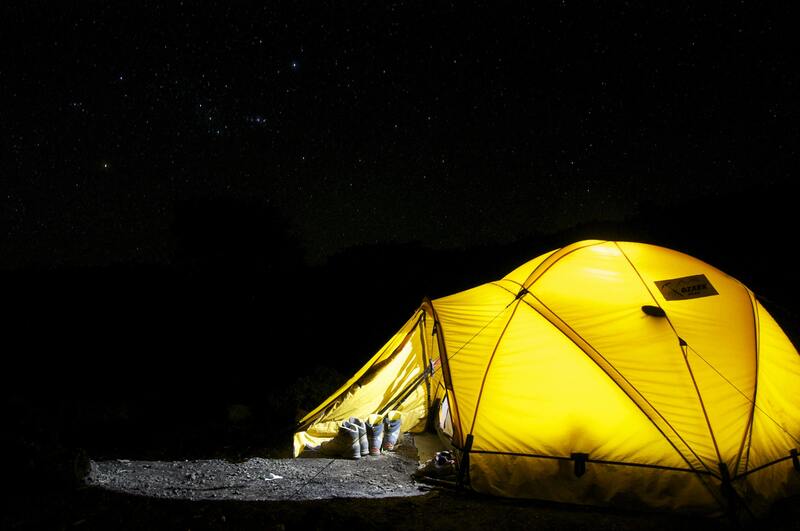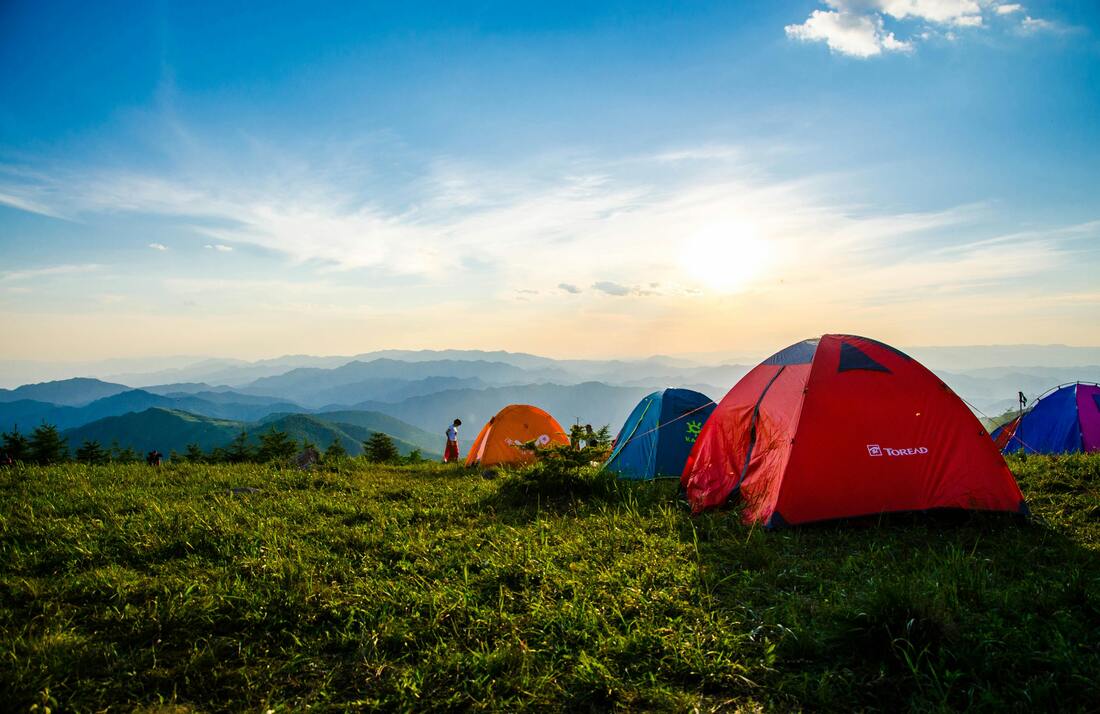Portable camping is all about setting up a simple, lightweight camp that's easy to move. It's perfect if you're hiking, driving around, or just trying to pack light. The key is to use gear that's small, efficient, and can handle different situations.
🔹 Smart Packing Tips
Put the heaviest stuff closest to your back, right in the middle.
Squish things down with compression sacks and packing cubes.
Pack in this order: shelter, sleep stuff, cooking gear, clothes, emergency kit, and the things you'll need quick access to.
🔹 Staying Safe
Always let someone know where you're headed and when you'll be back.
Keep an eye on the weather and pack the right stuff.
If there are bears around, use a bear bag or canister.
Always Leave No Trace: That means pack out *everything*.
Be super careful with campfires. Follow the local rules and make sure it's *completely* out before you leave.
🔹 Setting Up Camp
Find a spot that's flat and dry, away from cliffs, water, and animal paths.
Try to find some rocks or trees to block the wind.
Point your tent away from the direction the wind is usually blowing.
Use those tent lines and stakes, even if it doesn't seem windy.
Put a tarp under your tent to protect it.
🔹 Food and Water
Boil or purify water you find in nature.
Skip the heavy cans and bring light, high-calorie food.
Keep your food away from where you sleep (hang it in a tree or use smell-proof bags).
Take food out of bulky packaging to save space.
🔹 Taking Care of Nature
Use soap that won't hurt the environment.
When you go to the bathroom, dig a hole 6–8 inches deep and at least 200 feet away from water.
Don't leave *anything* behind – no trash, food, or gear.
Use rechargeable batteries or a solar charger.
🔹 Weather Stuff
Here's what to pack depending on the time of year:
* **Winter:** A tent that can handle all seasons, a warm sleeping bag, extra clothes, and stakes for snow.
* **Summer:** A mosquito net, clothes that breathe, and sun protection.
* **Rainy:** Extra tarps, waterproof bags, and clothes that dry fast.
🔹 Things to Avoid
* Bringing too much stuff
* Not planning enough for water and food
* Not trying out your gear before you go
* Ignoring the weather
* Wearing cotton clothes (they get wet and stay wet)
* Forgetting first-aid stuff or fire starters
🔹 Bonus Tips from Experienced Campers
* Try out all your gear at home first.
* Keep a set of clothes just for sleeping that are always dry.
* Don't cheap out on sleeping gear or you'll have a miserable time.
* Always have a backup plan for your route, where you'll sleep, and if the weather gets bad.
* Use a checklist before you leave to make sure you have everything.
Put the heaviest stuff closest to your back, right in the middle.
Squish things down with compression sacks and packing cubes.
Pack in this order: shelter, sleep stuff, cooking gear, clothes, emergency kit, and the things you'll need quick access to.
🔹 Staying Safe
Always let someone know where you're headed and when you'll be back.
Keep an eye on the weather and pack the right stuff.
If there are bears around, use a bear bag or canister.
Always Leave No Trace: That means pack out *everything*.
Be super careful with campfires. Follow the local rules and make sure it's *completely* out before you leave.
🔹 Setting Up Camp
Find a spot that's flat and dry, away from cliffs, water, and animal paths.
Try to find some rocks or trees to block the wind.
Point your tent away from the direction the wind is usually blowing.
Use those tent lines and stakes, even if it doesn't seem windy.
Put a tarp under your tent to protect it.
🔹 Food and Water
Boil or purify water you find in nature.
Skip the heavy cans and bring light, high-calorie food.
Keep your food away from where you sleep (hang it in a tree or use smell-proof bags).
Take food out of bulky packaging to save space.
🔹 Taking Care of Nature
Use soap that won't hurt the environment.
When you go to the bathroom, dig a hole 6–8 inches deep and at least 200 feet away from water.
Don't leave *anything* behind – no trash, food, or gear.
Use rechargeable batteries or a solar charger.
🔹 Weather Stuff
Here's what to pack depending on the time of year:
* **Winter:** A tent that can handle all seasons, a warm sleeping bag, extra clothes, and stakes for snow.
* **Summer:** A mosquito net, clothes that breathe, and sun protection.
* **Rainy:** Extra tarps, waterproof bags, and clothes that dry fast.
🔹 Things to Avoid
* Bringing too much stuff
* Not planning enough for water and food
* Not trying out your gear before you go
* Ignoring the weather
* Wearing cotton clothes (they get wet and stay wet)
* Forgetting first-aid stuff or fire starters
🔹 Bonus Tips from Experienced Campers
* Try out all your gear at home first.
* Keep a set of clothes just for sleeping that are always dry.
* Don't cheap out on sleeping gear or you'll have a miserable time.
* Always have a backup plan for your route, where you'll sleep, and if the weather gets bad.
* Use a checklist before you leave to make sure you have everything.
Okay, here's a rewrite of that camping information to make it sound more like a regular person wrote it:
🔥 Campfires (If They're Allowed)
First things first, fire safety:
* Check if you can even *have* a fire where you are.
* If there's a fire ring already, use it.
* Clear away anything that could burn within 10 feet of the ring.
Making the fire:
* You need small stuff (dry leaves, bark), then a bit bigger (twigs), then logs.
* You can pile it like a teepee, log cabin, or lean-to.
* Use something to get it going fast like cotton balls with petroleum jelly, or dryer lint.
Putting it out for good:
* Drench it with water, stir it up, and do that again until it's cool to the touch.
* Don't leave a fire burning when you're not watching it.
🔥 Quick tip: A portable stove is faster, cleaner, and safer.
🧠 Cool Camping Tricks (Easy and Light)
🧼 Soap trick: Grate a bar of soap ahead of time.
🔥 cotton balls with petroleum jelly: great fire starter
📦 Spice straws: Fill straws with spices, toothpaste/ointment, melt to seal them.
💧 Bandanas: Can filter water, protect you from the sun, be a pot holder, and be used as a makeshift sling.
🍳 Foil meals: Wrap up food in tin foil to cook easy
🧴 Refills: Use eyedrop bottles for soap, oil, sunscreen.
💡 Solar lights: Charge during the day, hang in your tent at night.
📓 Duct tape: Wrap some duct tape around your bottle for emergencies.
🗺️ How Not to Get Lost
* Download maps to your phone or GPS so you can use them without internet.
* Bring a paper map and compass, just in case.
* Note where you can find water, how high you'll be climbing, and different ways to get out.
* Learn how to read those topo maps, like what the lines mean.
* Write down where your camp is so you can find it again.
🧳 Pack Smart by Category
Pack gear in bags by categories
*Sleep Kit – Bag, pad, liner, sleepwear
*Cook Kit – Stove, fuel, lighter, pot, spork, food bag
*Water Kit – Filter, bottle, purification tabs
*Hygiene Kit – Wipes, soap, towel, brush, trowel
*Weather Kit – Rain gear, hat, gloves, extra socks
*Tool Kit – Knife, multitool, duct tape, zip ties
*Nav/Signal Kit – Map, compass, whistle, mirror
📚 Skills That Come in Handy
* Tying knots (bowline, taut-line hitch, trucker's hitch)
* Basic first aid skills
* Starting a fire even when it's wet
* Finding your way without GPS
* Finding and cleaning water
* Knowing what the clouds and wind mean
🔥 Campfires (If They're Allowed)
First things first, fire safety:
* Check if you can even *have* a fire where you are.
* If there's a fire ring already, use it.
* Clear away anything that could burn within 10 feet of the ring.
Making the fire:
* You need small stuff (dry leaves, bark), then a bit bigger (twigs), then logs.
* You can pile it like a teepee, log cabin, or lean-to.
* Use something to get it going fast like cotton balls with petroleum jelly, or dryer lint.
Putting it out for good:
* Drench it with water, stir it up, and do that again until it's cool to the touch.
* Don't leave a fire burning when you're not watching it.
🔥 Quick tip: A portable stove is faster, cleaner, and safer.
🧠 Cool Camping Tricks (Easy and Light)
🧼 Soap trick: Grate a bar of soap ahead of time.
🔥 cotton balls with petroleum jelly: great fire starter
📦 Spice straws: Fill straws with spices, toothpaste/ointment, melt to seal them.
💧 Bandanas: Can filter water, protect you from the sun, be a pot holder, and be used as a makeshift sling.
🍳 Foil meals: Wrap up food in tin foil to cook easy
🧴 Refills: Use eyedrop bottles for soap, oil, sunscreen.
💡 Solar lights: Charge during the day, hang in your tent at night.
📓 Duct tape: Wrap some duct tape around your bottle for emergencies.
🗺️ How Not to Get Lost
* Download maps to your phone or GPS so you can use them without internet.
* Bring a paper map and compass, just in case.
* Note where you can find water, how high you'll be climbing, and different ways to get out.
* Learn how to read those topo maps, like what the lines mean.
* Write down where your camp is so you can find it again.
🧳 Pack Smart by Category
Pack gear in bags by categories
*Sleep Kit – Bag, pad, liner, sleepwear
*Cook Kit – Stove, fuel, lighter, pot, spork, food bag
*Water Kit – Filter, bottle, purification tabs
*Hygiene Kit – Wipes, soap, towel, brush, trowel
*Weather Kit – Rain gear, hat, gloves, extra socks
*Tool Kit – Knife, multitool, duct tape, zip ties
*Nav/Signal Kit – Map, compass, whistle, mirror
📚 Skills That Come in Handy
* Tying knots (bowline, taut-line hitch, trucker's hitch)
* Basic first aid skills
* Starting a fire even when it's wet
* Finding your way without GPS
* Finding and cleaning water
* Knowing what the clouds and wind mean



